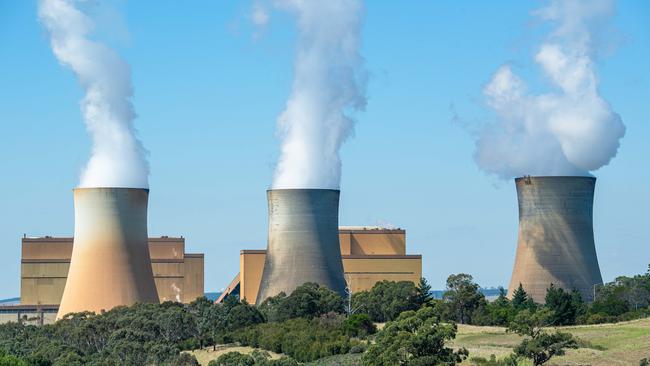
As well as battery, pumped hydro and hydrogen storage, there is another way to support solar and wind, and that is to use rapid-start natural gas generation. This is a highly flexible, large-scale, on-demand technology. With natural gas and pumped hydro, batteries at small scale today but increasingly available, and in the long term some hydrogen storage, we can introduce large amounts of solar and wind stably and manage daily shortfalls, as well as the rare, prolonged shortfalls.
There is much debate about the use of natural gas as we make the transition to a zero-emissions electricity system. Some of the discussion is at cross-purposes, because the word “transition” is ambiguous. I now prefer to be specific and talk about natural gas either in a “replacement” or a “firming” role.
Replacement is where high-emissions coal-fired electricity generation is shut down and instead provided by lower-emissions natural gas. This approach has been used in some places. For example, natural gas has replaced a substantial fraction of coal generation in the US, which has played a part in reducing emissions from the electricity sector there by 28 per cent between 2005 and 2018.
In Britain, in a major success story, coal-fired electricity production fell from a 67 per cent share in 1990 to just 2 per cent by the end of 2019. At the same time, electricity produced from natural gas increased from virtually zero to nearly 41 per cent, to replace much of that previously supplied by coal generators.
In South Australia, the last coal-fired generator closed in May 2016. In the next two years, to replace that coal-fired electricity generator, natural gas-fired electricity jumped from 37 per cent to 52 per cent of the annual electricity output. This share is falling, as ever more solar, wind and batteries enter the system.
In each of these cases, natural gas was used to replace coal-fired electricity. However, time and technology have moved on. We now have the realistic prospect of replacing coal with the combination of solar, wind and batteries. It can’t be done immediately because of the cost and availability of batteries. But if we are prepared to continue to use natural gas for firming, we can be confident of using solar and wind to replace coal generators when they close. With time, less natural gas will be needed and it will eventually be replaced by ever larger, more cost-effective batteries, pumped hydro and, in some cases, stored hydrogen.
In the large east-coast states of Australia, the situation is different from in Britain and South Australia. Take NSW as an example. In the year to June 2019, coal-fired electricity was 79 per cent of the annual output and natural gas-fired electricity just 2 per cent. The NSW government has legislated a major shift to solar and wind, signalling it will ultimately exit coal power by shifting the generation mix directly to renewables without using natural gas as a replacement. To achieve this, as well as supporting the commissioning of 12 gigawatts of new solar and wind capacity by 2030, the government will support firming by natural gas and battery storage. This approach is the quickest way to achieve near-zero emissions. I say “near-zero” because in this firming scenario emissions from the gas generators for the small number of hours they would operate, averaged over the course of the year, would be negligible. It is not clear at this time whether existing gas generators will be sufficient to provide firming services.
Market forces will ensure the use of natural gas is minimised. Put simply, because of the cost of natural gas as a fuel, gas always yields to wind and solar when they are available. Ultimately, use of natural gas as one of the firming technologies will be replaced by yet more batteries and pumped hydro, or by converting the remaining gas generators to run on hydrogen. The majority of existing natural gas turbines can be modified to run on a hydrogen blend of up to 50 per cent, or in some cases up to 80 per cent.
The near-term and medium-term issue is whether we should allow the pursuit of perfection to get in the way of the very good. Gas generators can provide firming services that enable solar and wind to be scaled up very rapidly without risking reliability of supply. That is, we can achieve the very good quickly by using gas in the mix, then approach perfection — zero emissions — as the technology matures.
There is a myth about gas that I should address. This is that if you take into account the upstream fugitive emissions associated with natural gas production, emissions from a gas-fired generator are worse than from a coal-fired generator. This assertion relies on an unequal comparison. A fair comparison should take into account the upstream fugitive emissions associated with coal production. For coal, there are upstream methane emissions in mining and crushing. For natural gas, there are upstream methane emissions from the wellhead, handling equipment and pipelines.
A comprehensive analysis commissioned by the Northern Territory government compares coal generators with open-cycle gas turbines that provide rapid-start generation for firming. Even including upstream emissions, gas-fired electricity is in all cases lower in emissions than coal-fired electricity.
In September 2020, I received a letter from 25 scientists taking issue with my expectation that natural gas will be a part of Australia’s energy mix for many years to come. The scientists want to phase out gas as quickly as possible and insist there is no place for expanded gas infrastructure in Australia, given the significant contribution of gas to carbon dioxide emissions. Where we differ is not the science; it is in what we regard as a realistic way forward. My contention is that the use of gas for firming will allow more solar and wind generation into the electricity grid sooner than otherwise. Gas can ease the way through to the closure of coal-fired power stations. Batteries and pumped hydro will also solve the firming problem, and will be the long-term answer, but natural gas will get us close, more quickly, in the interim. Natural gas can be phased out once hydrogen has been scaled up and commercialised across the spectrum of our energy needs.
One of the authors of the letter said I was addressing engineering problems, rather than the need to meet the looming Paris temperature limits. It is true: my approach is that of an engineer. My goal is for us to achieve a low-emissions economy as fast as is practicable. And intrinsic to engineering is the realisation that pursuit of perfection does not deliver a finished product. Engineering is the art of optimisation. Design a perfect bridge and it will be too expensive to build. Compromise the design of a bridge and it will collapse. The job of an engineer is to optimise the design. So, too, in everything.
Alan Finkel was Australia’s chief scientist between 2016 and 2020, and is currently special adviser to the Australian government on low-emissions technologies. This is an edited extract from his Quarterly Essay, Getting to Zero: Australia’s Energy Transition published today.




We’ve all heard the question: “How will a future renewable energy electricity system cope when the sun isn’t shining and the wind isn’t blowing?” The answer is almost biblical: store the electrical energy when it is abundant, for use when there is famine. The technical term is “firming”. The need for firming arises on a daily basis, and to overcome infrequent but potentially lengthy weather-related drops in output.